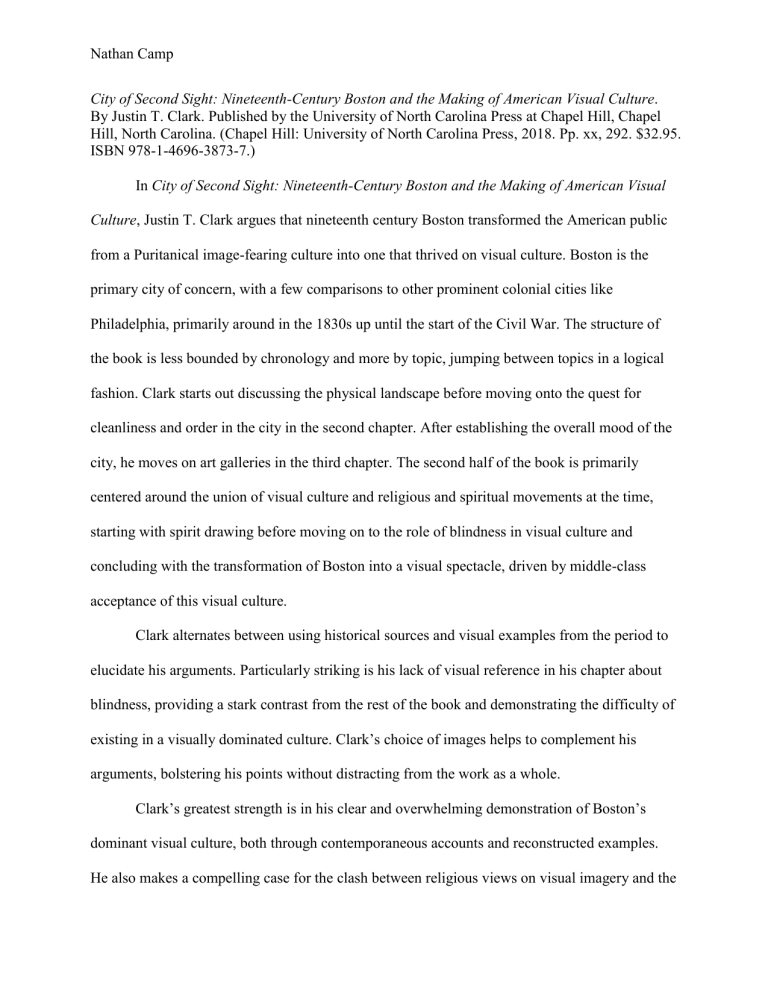
Nathan Camp City of Second Sight: Nineteenth-Century Boston and the Making of American Visual Culture. By Justin T. Clark. Published by the University of North Carolina Press at Chapel Hill, Chapel Hill, North Carolina. (Chapel Hill: University of North Carolina Press, 2018. Pp. xx, 292. $32.95. ISBN 978-1-4696-3873-7.) In City of Second Sight: Nineteenth-Century Boston and the Making of American Visual Culture, Justin T. Clark argues that nineteenth century Boston transformed the American public from a Puritanical image-fearing culture into one that thrived on visual culture. Boston is the primary city of concern, with a few comparisons to other prominent colonial cities like Philadelphia, primarily around in the 1830s up until the start of the Civil War. The structure of the book is less bounded by chronology and more by topic, jumping between topics in a logical fashion. Clark starts out discussing the physical landscape before moving onto the quest for cleanliness and order in the city in the second chapter. After establishing the overall mood of the city, he moves on art galleries in the third chapter. The second half of the book is primarily centered around the union of visual culture and religious and spiritual movements at the time, starting with spirit drawing before moving on to the role of blindness in visual culture and concluding with the transformation of Boston into a visual spectacle, driven by middle-class acceptance of this visual culture. Clark alternates between using historical sources and visual examples from the period to elucidate his arguments. Particularly striking is his lack of visual reference in his chapter about blindness, providing a stark contrast from the rest of the book and demonstrating the difficulty of existing in a visually dominated culture. Clark’s choice of images helps to complement his arguments, bolstering his points without distracting from the work as a whole. Clark’s greatest strength is in his clear and overwhelming demonstration of Boston’s dominant visual culture, both through contemporaneous accounts and reconstructed examples. He also makes a compelling case for the clash between religious views on visual imagery and the Nathan Camp subsequent embrace of said imagery by other spiritual movements. This is a prominent story throughout the narrative of the book and it seems as though the organization had been organized around this or some other stronger central theme. As matters stand, the book is a collection of loosely related chapters that connect to a central theme but don’t flow into each other particularly well. One area that this is especially highlighted is in the sixth chapter when Clark discusses the increase in spectacle in Boston, mostly revolving around fairy tales. The tone of the chapter is completely dissonant from the previous five and while he brings it back around to a discussion on the shifting attitudes of mid-nineteenth century Bostonians toward spectacle and visual culture, the entrance into the topic is radically different from the remainder of the book and sticks out needlessly as a result. The writing of this book is one of its greatest strengths however. The prose from one sentence to the next is eminently readable, never getting bogged down in an overly technically explanation or explaining any unfamiliar concepts for readers not as well versed on the subject matter. The book feels written on an undergraduate level in terms of its writing style which should make it useful for those brave enough to subject their students to a monograph. Clark’s sentences flow together smoothly and help to create a clear and entertaining picture without getting bogged down in overly technical details or unhelpful syntax choices. Justin T. Clark makes a compelling argument that he illuminates with thoroughly researched and brilliantly detailed examples. City of Second Sights is readable on the whole, usable in part for an undergraduate course and in its entirety in any appropriate graduate course. Though organizational problems weaken the overall structure of the book, the argument still stands and it remains a useful work in understanding nineteenth century Bostonian attitudes toward visual culture and the evolution of American thoughts toward visual culture on the whole.


